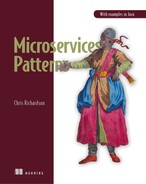List of Listings
Chapter 3. Interprocess communication in a microservice architecture
Listing 3.1. An excerpt of the gRPC API for the Order Service
Chapter 4. Managing transactions with sagas
Listing 4.1. The OrderService class and its createOrder() method
Listing 4.2. The definition of the CreateOrderSaga
Listing 4.3. The definition of the third step of the saga
Listing 4.4. CreateOrderSagaState stores the state of a saga instance
Listing 4.5. KitchenServiceProxy defines the command message endpoints for Kitchen Service
Chapter 5. Designing business logic in a microservice architecture
Listing 5.1. The OrderCreated event and the DomainEventEnvelope class
Listing 5.2. The enriched OrderCreated event
Listing 5.3. The Ticket aggregate’s accept() method
Listing 5.4. KitchenService calls Ticket.accept()
Listing 5.5. The Ticket extends a superclass, which records domain events
Listing 5.6. The Eventuate Tram framework’s DomainEventPublisher interface
Listing 5.7. The abstract superclass of type-safe domain event publishers
Listing 5.8. A type-safe interface for publishing Ticket aggregates’ domain events
Listing 5.9. Dispatching events to event handler methods
Listing 5.10. Part of the Ticket class, which is a JPA entity
Listing 5.11. Some of the Ticket’s methods
Listing 5.12. The service’s accept() method updates Ticket
Listing 5.13. Handling command messages sent by sagas
Listing 5.14. The Order class and its fields
Listing 5.15. The methods that are invoked during order creation
Listing 5.16. The Order method for revising an Order
Listing 5.17. The OrderService class has methods for creating and managing orders
Chapter 6. Developing business logic with event sourcing
Listing 6.1. The Order aggregate’s fields and its methods that initialize an instance
Listing 6.2. The process() and apply() methods that revise an Order aggregate
Listing 6.3. The Eventuate version of the Order class
Listing 6.4. OrderService uses an AggregateRepository
Chapter 7. Implementing queries in a microservice architecture
Listing 7.1. Event handlers that call the OrderHistoryDao
Listing 7.2. The addOrder() method adds or updates an Order
Listing 7.3. The notePickedUp() method changes the order status to PICKED_UP
Listing 7.4. The idempotentUpdate() method ignores duplicate events
Listing 7.5. The findOrderHistory() method retrieves a consumer’s matching orders
Chapter 8. External API patterns
Listing 8.1. Fetching the order details by calling the backend services sequentially
Listing 8.2. The Spring @Beans that implement the /orders endpoints
Listing 8.3. The externalized configuration of backend service URLs
Listing 8.4. The OrderHandlers class implements custom request-handling logic.
Listing 8.5. OrderService class—a remote proxy for Order Service
Listing 8.6. The main() method for the API gateway
Listing 8.7. The GraphQL schema for the FTGO API gateway
Listing 8.8. Attaching the resolver functions to fields of the GraphQL schema
Listing 8.9. Using a DataLoader to optimize calls to Restaurant Service
Listing 8.10. Integrating the GraphQL server with the Express web framework
Listing 8.11. Using the Apollo GraphQL client to execute queries
Chapter 9. Testing microservices: Part 1
Listing 9.1. A contract that describes how API Gateway invokes Order Service
Listing 9.2. A simple, fast-running unit test for the Order entity
Listing 9.3. A simple, fast-running test for the Money value object
Listing 9.4. A simple, fast-running unit test for CreateOrderSaga
Listing 9.5. A simple, fast-running unit test for the OrderService class
Listing 9.6. A simple, fast-running unit test for the OrderController class
Listing 9.7. A fast-running unit test for the OrderEventConsumer class
Chapter 10. Testing microservices: Part 2
Listing 10.1. An integration test that verifies that an Order can be persisted
Listing 10.2. A contract that describes an HTTP-based request/response style interaction
Listing 10.3. The abstract base class for the tests code-generated by Spring Cloud Contract
Listing 10.4. A consumer-side integration test for API Gateway’s OrderServiceProxy
Listing 10.5. A contract for a publish/subscribe interaction style
Listing 10.6. The abstract base class for the Spring Cloud Contract provider-side tests
Listing 10.7. The consumer-side integration test for the OrderHistoryEventHandlers class
Listing 10.8. Contract describing how Order Service asynchronously invokes Kitchen Service
Listing 10.9. The consumer-side contract integration test for Order Service
Listing 10.10. Superclass of provider-side, consumer-driven contract tests for Kitchen Service
Listing 10.11. The Gherkin definition of the Place Order feature and some of its scenarios
Listing 10.12. The Java step definitions class makes the Gherkin scenarios executable.
Listing 10.15. The @ThentheOrderShouldBe() method verifies HTTP request was successful.
Listing 10.16. The Cucumber step definitions class for the Order Service component tests
Listing 10.17. A Gherkin-based specification of a user journey
Chapter 11. Developing production-ready services
Listing 11.1. OrderService tracks the number of orders placed, approved, and rejected.
Chapter 12. Deploying microservices
Listing 12.1. The Dockerfile used to build Restaurant Service
Listing 12.2. The shell commands used to build the container image for Restaurant Service
Listing 12.3. Using docker run to run a containerized service
Listing 12.4. Kubernetes Deployment for ftgo-restaurant-service
Listing 12.5. The YAML definition of the Kubernetes service for ftgo-restaurant-service
Listing 12.7. Deploying Consumer Service with Istio
Listing 12.8. A Java lambda function is a class that implements the RequestHandler interface.
Listing 12.9. The handler class for GET /restaurant/{restaurantId}
Listing 12.10. An abstract RequestHandler that implements dependency injection
Listing 12.11. An abstract RequestHandler that catches exceptions and returns a 500 HTTP response
Listing 12.12. The serverless.yml deploys Restaurant Service.
